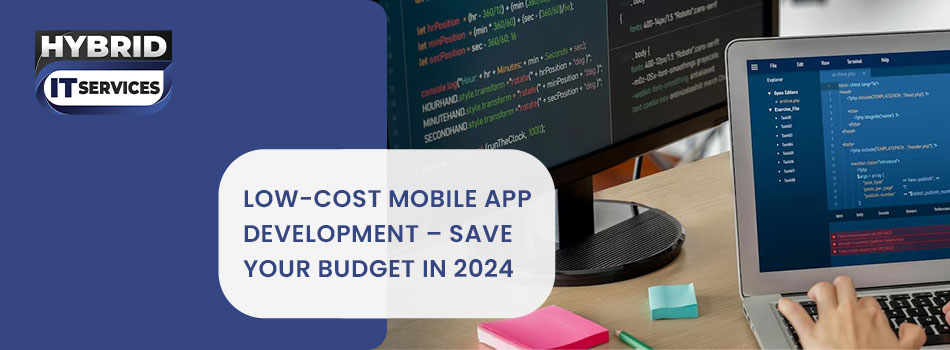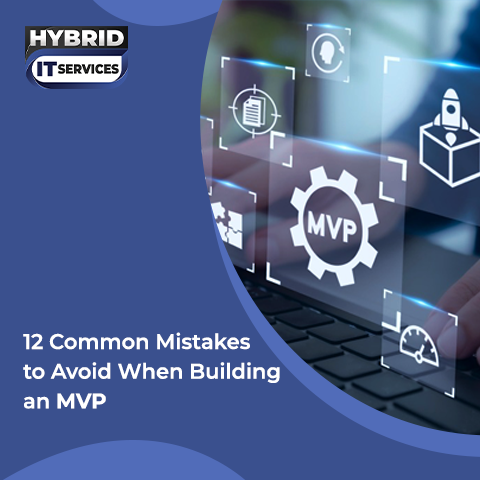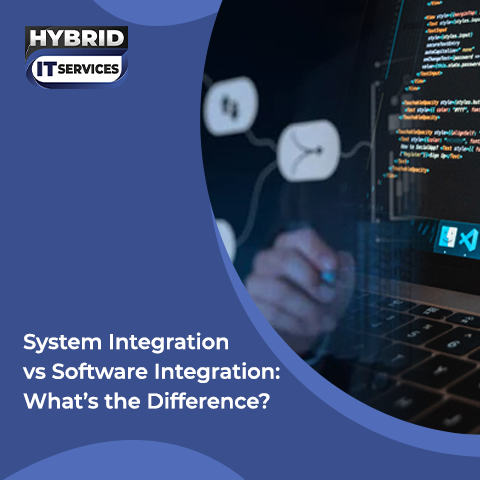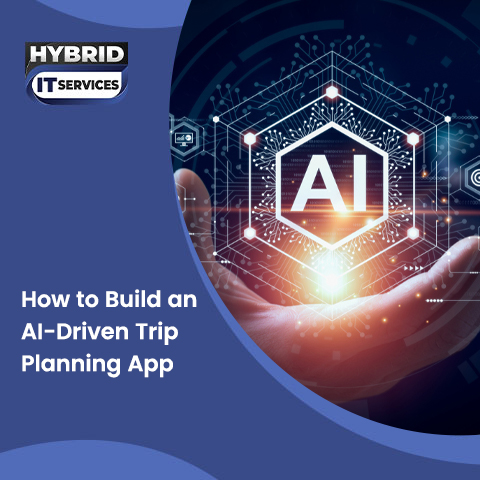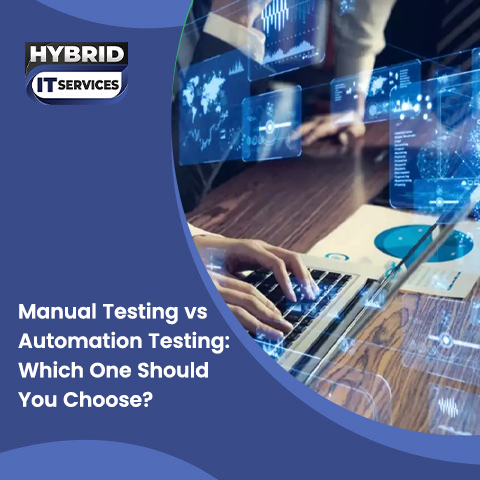Mobile Apps have become integral to business success. However, the journey from concept to launch can be daunting, especially when it comes to managing costs. Low-cost mobile app development is about making smart decisions that allow you to get the most value for your investment. At Hybrid IT Service, let's see various aspects of mobile app development expenses in 2024. Providing you with a clear understanding of how to navigate these costs without compromising on quality.
Understanding Mobile App Development Costs
Mobile app development costs are influenced by a multitude of factors. These include the complexity of the app, the number of features, the development platform, and the location of your development team. Understanding these factors is crucial for budgeting effectively and ensuring that you get a quality app that meets your needs. The key to low-cost mobile app development lies in balancing these factors to achieve a product that is both functional and affordable.
Mobile App Development Expenses 2024
As we move through 2024, the mobile app development industry continues to evolve, driven by advancements in technology and changes in user expectations. The cost of developing a mobile app in 2024 reflects these trends. For instance, the integration of new technologies like artificial intelligence (AI) and machine learning (ML) can increase development costs. But they also offer enhanced functionalities that can set your app apart in the market.
Breakdown of Mobile App Development Expenses
To provide a clearer picture of the costs associated with mobile app development in 2024. Let's break down the expenses based on various factors. For affordable mobile app development, it’s important to know the cost factors. Each of these factors contributes to the overall budget and should be carefully considered when planning your app.
| Factor | Estimated Cost (USD) |
| Basic App Development | $5,000 - $20,000 |
| Complex App Development | $20,000 - $50,000 |
| Enterprise-Level App | $50,000 - $150,000 |
| UI/UX Design | $2,000 - $15,000 |
| Backend Development | $5,000 - $20,000 |
| API Integration | $2,000 - $10,000 |
| Testing & Quality Assurance | $3,000 - $10,000 |
| Maintenance & Updates | $500 - $2,000 |
These estimates provide a broad overview, but the actual costs can vary depending on the specific requirements of your app. For example, a basic app might include simple features like a login screen and user profile. A complex app could require integration with third-party services, real-time data processing, or advanced security features.
Cost Analysis by Application Type
The type of application you want to develop is one of the most significant factors influencing the overall cost. Here’s a closer look at how different application types can affect your budget:
- Basic Apps: These apps typically have limited functionality and are designed to perform a few key tasks. Examples include informational apps, simple games, or apps that provide a basic service, like a calculator. Development costs for basic apps are generally lower, as they require less time and fewer resources to build.
- E-commerce Apps: These apps enable users to browse products, make purchases, and manage their accounts. E-commerce apps often require features like product catalogs, payment gateways, and user authentication, which can increase development costs.
- On-Demand Apps: Popularized by services like Uber and Airbnb, on-demand apps connect users with service providers in real time. These apps often require complex backend systems, GPS tracking, and real-time notifications, making them more expensive to develop.
- Enterprise Apps: Designed for large organizations, enterprise apps often integrate with existing systems and offer advanced functionalities like data analytics, real-time collaboration, and secure communication channels. Due to their complexity, enterprise apps are typically the most expensive to develop.
Platform-Specific Mobile App Development Costs
Another critical decision you'll need to make is which platform to target: iOS, Android, or a hybrid solution. Each platform has its own set of development costs, influenced by factors such as the programming languages used, the availability of development tools, and the specific requirements of the platform.
iOS App Development Expenses
Developing an app for iOS requires adherence to Apple’s strict guidelines, which can affect both the cost and the development timeline. Apple’s ecosystem is known for its high-quality user experience, but achieving this standard often requires more effort in terms of design, development, and testing. Below is a cost estimate for developing an iOS app in 2024:
| iOS App Type | Estimated Cost (USD) |
| Simple App | $10,000 - $25,000 |
| Medium Complexity App | $25,000 - $50,000 |
| High Complexity App | $50,000 - $100,000 |
The cost can also vary depending on whether you’re developing a native iOS app, which is built specifically for Apple devices, or a cross-platform app that works on multiple platforms.
Android App Development Expenses
Android app development is often more time-consuming due to the wide range of devices and operating system versions that need to be supported. However, the development cost can be lower or comparable to iOS, depending on the complexity of the app. Here’s a cost estimate for Android app development in 2024:
|
Android App Type |
Estimated Cost (USD) |
|
Simple App |
$8,000 - $20,000 |
|
Medium Complexity App |
$20,000 - $45,000 |
|
High Complexity App |
$45,000 - $90,000+ |
Android’s open-source nature allows for greater flexibility in development, but it also means dealing with more fragmentation, which can increase the cost of testing and optimization.
Hybrid App Development Expenses
Hybrid apps are designed to work across multiple platforms, making them a cost-effective solution for businesses that want to reach both iOS and Android users. However, they may require more upfront investment in development to ensure they perform well on all platforms. Here’s a cost estimate for hybrid app development in 2024:
|
Hybrid App Type |
Estimated Cost (USD) |
|
Simple Hybrid App |
$15,000 - $30,000 |
|
Medium Complexity Hybrid App |
$30,000 - $60,000 |
|
High Complexity Hybrid App |
$60,000 - $120,000+ |
Hybrid apps use frameworks like React Native or Flutter to create a single codebase that runs on multiple platforms, which can save time and reduce costs compared to developing separate native apps.
Cost Breakdown by Features and Functionalities
The features and functionalities you want to include in your app will have a significant impact on the overall development cost. Basic features like user authentication and push notifications are relatively inexpensive to implement, while more complex functionalities like real-time chat, GPS tracking, and payment gateways can increase costs significantly.
|
Feature/Functionality |
Estimated Cost (USD) |
|
User Authentication |
$2,000 - $5,000 |
|
In-App Purchases |
$3,000 - $7,000 |
|
Push Notifications |
$1,500 - $5,000 |
|
Social Media Integration |
$2,000 - $5,000 |
|
GPS/Location Services |
$3,000 - $8,000 |
|
Real-Time Chat |
$5,000 - $15,000 |
Choosing which features to include in your app should be based on your business goals and the needs of your users. It’s also essential to prioritize these features, as adding too many at once can inflate your budget and extend the development timeline.
Regional Variations in Mobile App Development Costs
The location of your development team can significantly influence the cost of developing a mobile app. Developers in different regions charge varying rates based on the local cost of living, demand for their services, and industry standards. Here’s a breakdown of average hourly rates by region:
|
Region |
Hourly Rate (USD) |
|
North America |
$100 - $150 |
|
Western Europe |
$70 - $120 |
|
Eastern Europe |
$30 - $70 |
|
Asia |
$20 - $50 |
While hiring developers from regions with lower rates can reduce costs, it’s important to consider the potential trade-offs in terms of quality, communication, and time zone differences. However, many companies in Eastern Europe and Asia offer high-quality development services at a fraction of the cost compared to North America or Western Europe.
Ongoing Maintenance Costs for Mobile Apps
Launching your app is just the beginning. To keep it running smoothly and ensure a great user experience, ongoing maintenance is required. This includes fixing bugs, updating the app to stay compatible with new operating system versions, and adding new features based on user feedback. Ongoing maintenance costs can vary depending on the complexity of your app and the frequency of updates.
Ignoring maintenance can lead to a decline in user satisfaction, as outdated apps can become slow, and unresponsive. And incompatible with newer devices and operating systems. Therefore, budgeting for ongoing maintenance is essential for the long-term success of your app.
Selecting the Right Development Partner
One of the most critical decisions in the mobile app development process is selecting the right development partner like Hybrid IT App Development services Arizona. The choice you make here will significantly impact both the cost and the quality of your app. The main options include hiring freelancers, building an in-house team, or partnering with an app development company. Each option has its own set of cost implications and considerations.
Freelancer vs. Other Development Options
Hiring a freelancer can be a cost-effective option, especially for small projects or specific tasks within a larger project. Freelancers often charge lower rates compared to development companies, but there are risks involved, such as inconsistent communication, variable quality, and potential delays. Freelancers might be a good choice if you have a small budget and are willing to manage the project closely.
In-House Development Costs
Building an in-house development team provides greater control over the project and ensures that the team is fully dedicated to your app. However, this option can be expensive, as it involves salaries, benefits, and the overhead costs of managing a team. In-house development is typically recommended for large enterprises or companies that plan to develop and maintain multiple apps over time.
Costs Involved with App Development Companies
App development companies offer a comprehensive service, handling everything from design to deployment. While this option can be more expensive, it often ensures a smoother and more professional development process. Development companies bring a team of experts, including designers, developers, testers, and project managers, to ensure that every aspect of your app is well-executed.
Partnering with a reputable development company can be a worthwhile investment, especially if you lack the technical expertise or resources to manage the development process in-house.
Conclusion
Mobile app development is a significant investment, but it can yield substantial returns if done correctly. By understanding the various factors that influence development costs. You can make informed decisions that align with your budget and business goals. Whether you choose to develop an app in-house, hire freelancers, or work with a development company, the key is to prioritize your app’s features. Select the right platform like Custom Mobile App Development Arizona, and plan for ongoing maintenance. By doing so, you can create a high-quality app that delivers value to your users while keeping costs under control.

